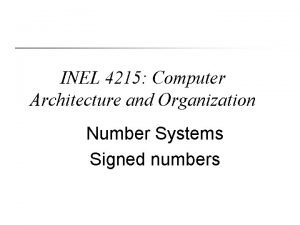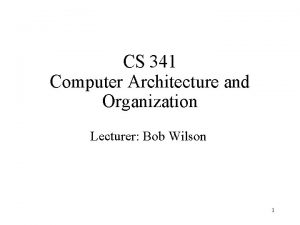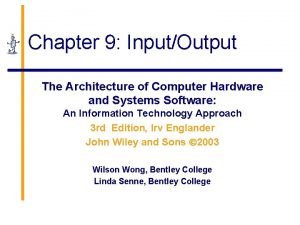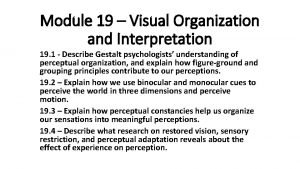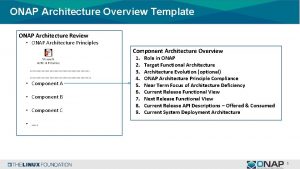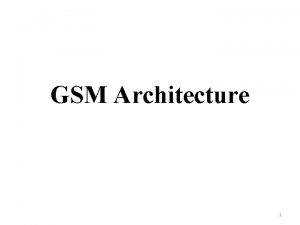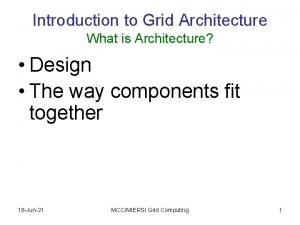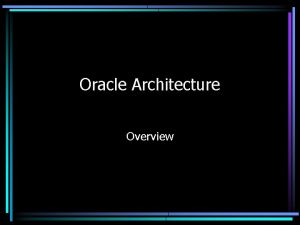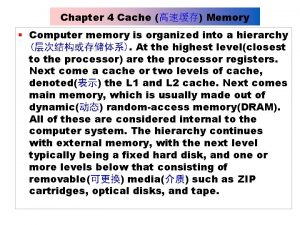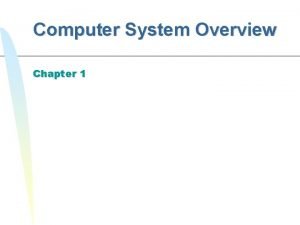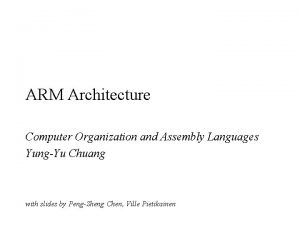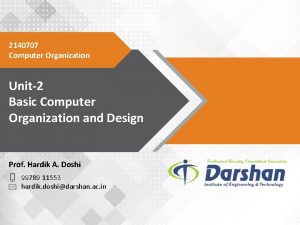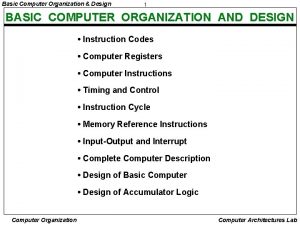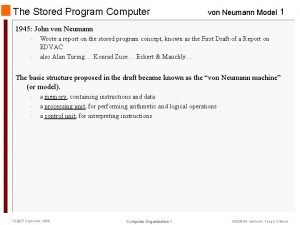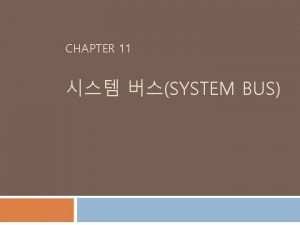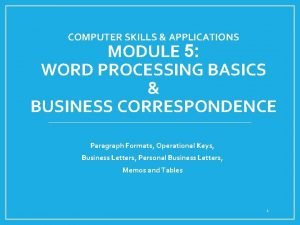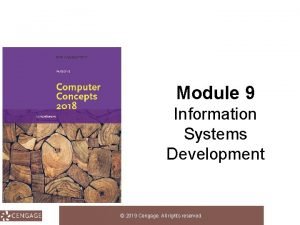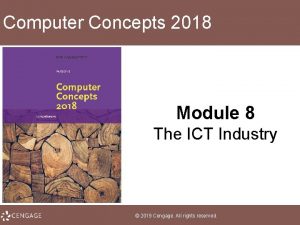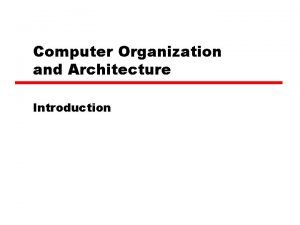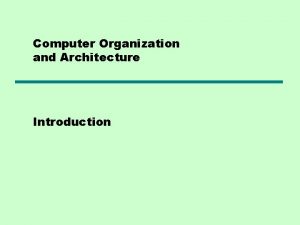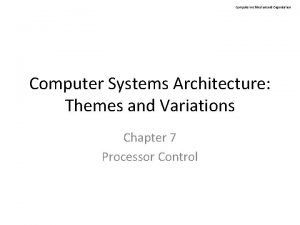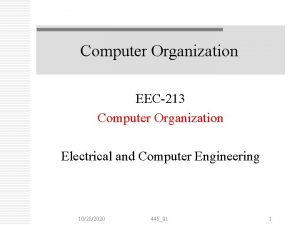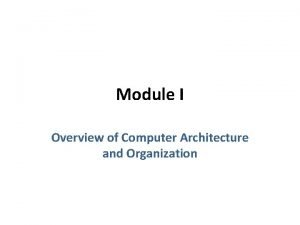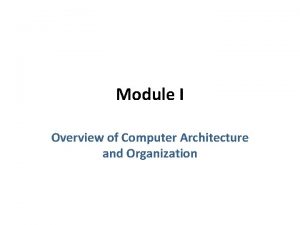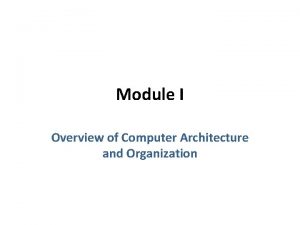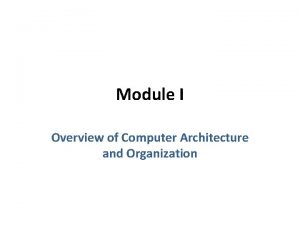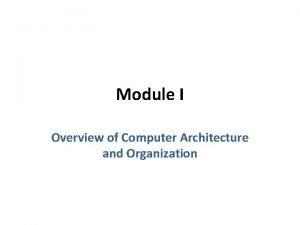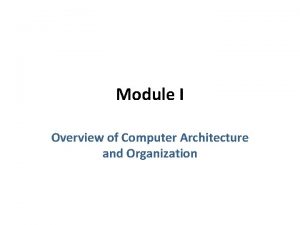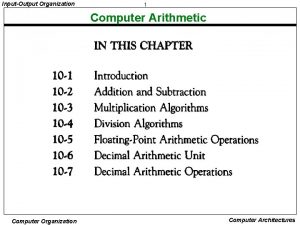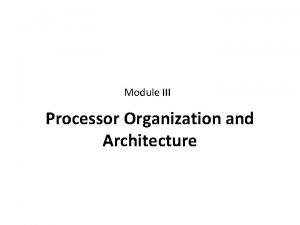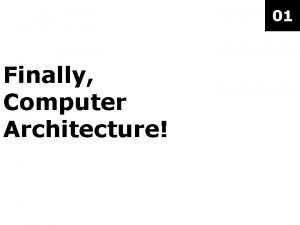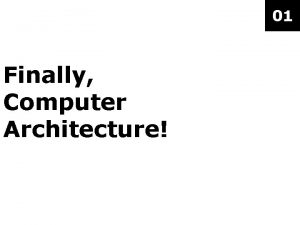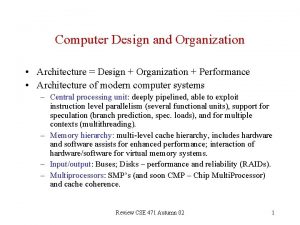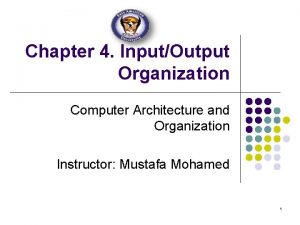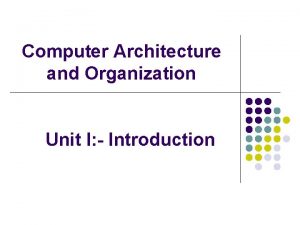Module I Overview of Computer Architecture and Organization






































- Slides: 38

Module I Overview of Computer Architecture and Organization

What is a Computer ? ? ?

Definition: Cambridge • It is an electronic machine that is used for storing, organizing, and finding words, numbers, and pictures, for doing calculations, and for controlling other machines

Definition • It is a fast electronic calculating machine that – accepts digitized input information – process it according to a list of internally stored information and – produces the resulting output information

Syllabus

Pre-requisites • Fundamentals of Computer • Digital Logic Circuits • Programming Languages (C, C++, Java)

Module 1 • Overview of Computer Architecture & Organization: • Introduction of Computer Organization and Architecture. • Basic organization of computer and block level description of the functional units. • Evolution of Computers, Von Neumann model. • Performance measure of Computer Architecture. • Introduction to buses and connecting I/O devices to CPU and Memory, bus structure.

Module 1 • Overview of Computer Architecture & Organization: • Introduction of Computer Organization and Architecture. • Basic organization of computer and block level description of the functional units. • Evolution of Computers, Von Neumann model. • Performance measure of Computer Architecture. • Introduction to buses and connecting I/O devices to CPU and Memory, bus structure.

Module 2 • Data Representation and Arithmetic Algorithms: • Number representation: Binary Data representation, two’s complement representation and Floating‐point representation. IEEE 754 floating point number representation. • Integer Data computation: Addition, Subtraction, Multiplication: Signed multiplication, Booth’s algorithm, Division of integers: Restoring and non‐ restoring division, Floating point arithmetic: Addition, subtraction

Module 3 • Processor Organization and Architecture: • CPU Architecture, Register Organization , Instruction formats, basic instruction cycle. Instruction interpretation and Sequencing. • Control Unit: Soft wired (Micro‐programmed) and hardwired control unit design methods. Microinstruction sequencing and execution. Micro operations, concepts of nano programming. • Introduction to RISC and CISC architectures and design issues. • Case study on 8085 microprocessor: Features, architecture, pin configuration and addressing modes.

Module 4 • Memory Organization: • Introduction to Memory and Memory parameters. Classifications of primary and secondary memories. Types of RAM and ROM, Allocation policies, Memory hierarchy and characteristics. Cache memory: Concept, architecture (L 1, L 2, L 3), mapping • techniques. Cache Coherency, Interleaved and Associative Memory Virtual Memory: Concept, Segmentation and Paging , Page replacement policies.

Module 5 • I/O Organization and Peripherals: • Input/output systems, I/O modules and 8089 IO processor. • Types of data transfer techniques: Programmed I/O, Interrupt driven I/O and DMA. • Peripheral Devices: Introduction to peripheral devices, scanner, plotter, joysticks, touch pad.

Module 6 • • § § § Introduction to parallel processing systems: Introduction to parallel processing concepts • Flynn’s classifications • pipeline processing • instruction pipelining, • pipeline stages • Pipeline hazards.

Text Books • 1. Carl Hamacher, Zvonko Vranesic and Safwat Zaky, “Computer Organization”, Fifth Edition, Tata Mc. Graw‐ Hill. • 2. John P. Hayes, “Computer Architecture and Organization”, Third Edition. • 3. William Stallings, “Computer Organization and Architecture: Designing for Performance”, Eighth Edition, Pearson. • 4. B. Govindarajulu, “Computer Architecture and Organization: Design Principles and Applications”, Second Edition, Tata Mc. Graw‐Hill.

Reference Books • 1. Dr. M. Usha, T. S. Srikanth, “Computer System Architecture and Organization”, First Edition, Wiley‐ India. • 2. “Computer Organization” by ISRD Group, Tata Mc. Graw‐Hill. • 3. Ramesh Gaonkar, “Microprocessor Architecture, Programming and Applications with the 8085, Fifth Edition, Penram.

Termwork • Term work should consist of at least 08 experiments. • Journal must include at least 2 assignments. • The final certification and acceptance of term work ensures that satisfactory performance • of laboratory work and minimum passing marks in term work. • Term Work: 25 Marks ( total marks ) = – 15 Marks ( Experiment ) + – 5 Marks ( Assignment ) + – 5 (Attendance (theory+practical)) • oral exam will be based on the above syllabus.

My Computer

Lenovo Desktop • • • Name & Model : Intel Core i 3‐ 2120 CPU Speed : 3. 3 GHz RAM : 2 GB 32‐bit Operating System Hard disk : 320 GB HOW MANY CORES ARE IN YOUR MOBILE?

Micro architecture • It is a description of the electrical circuitry of a computer central processing unit that is sufficient for completely describing the operation of the hardware.

Types of Computers • • • Desktop & Mobile Notebook Workstations Mainframes Servers Supercomputers

DESKTOP COMPUTERs • It has – Processing & Storage units(e. g. Hard disks, CD‐ROMs), – visual display &audio output units, – Input units ( keyboard, mouse, etc) • It can be easily located on a home or office desk • Used in homes, schools, business offices, …

NOTEBOOK COMPUTERs • Compact form of personal computer (laptop) • Size of a thin briefcase • Portable

WORKSTATIONs • Has high resolution graphics input/output capability • Has dimensions of desktop computer • More computational power than PC • Costlier • Used to solve complex problems which arises in engineering application

Mainframe • Also called Enterprise Systems • More computational power and storage than Workstation • Used for business data processing in medium to large corporations.

Servers • Contain big database storage units. • Handles large volumes of data requests • Requests and responses are transported via Internet • They are widely accessible to all.

Supercomputers • Faster than mainframes • Helps in large scale numerical calculations • Used for aircraft design and testing, military application, weather forecasting, etc.

Quiz

Question : 01 • The acronym PC stands for: A. Private Computer B. Personal Computer C. Personal Compact

Question : 02 • Complex scientific research is usually done using: A. Mainframe Computer B. Super Computer C. Mini Computer

Question : 03 • A laptop is an example for Personal Computer A. True B. False

Question : 04 • Which is not a Personal Computer A. Desktop B. Laptop C. Mainframe D. Tablet

Question : 05 • Mainframes are very cheap A. True B. False

This course is about: • What computers consist of • How computers work • How they are organized internally • What are the design tradeoffs • How design affects programming and applications • How to fix computers • How to build myself one real cheap • Which one to buy • Knowing all about the core i 3, i 5, i 7

Introduction of Computer Architecture and Organization

University Question • Differentiate between Computer Architecture and Organization (05 Marks)

Computer Architecture • Defn: It refers to the attributes of a system visible to a programmer that have a direct impact on the logical execution of a program • E. g. : Instruction set, No. of bits for various datatypes, …

Computer Organization • Defn: It refers to the operational units and their interconnections that realize the architectural specifications. • E. g. Interfaces, Memory Used, …

Example Architectural Issue Organizational Issue • Whether to have multiply instruction? • Whether to include a multiply unit or go for repeated addition?
 Difference between computer organisation and architecture
Difference between computer organisation and architecture Computer organization and architecture 10th solution
Computer organization and architecture 10th solution Software engineering virtual lab iit kharagpur
Software engineering virtual lab iit kharagpur Introduction to computer organization and architecture
Introduction to computer organization and architecture Spec rating formula in computer organization
Spec rating formula in computer organization Computer organization and architecture 10th edition
Computer organization and architecture 10th edition Computer arithmetic
Computer arithmetic Risc vs cisc example
Risc vs cisc example 1s complement
1s complement Cs341 umb
Cs341 umb Process organization in computer organization
Process organization in computer organization Input output
Input output 3 bus architecture
3 bus architecture Instruction set architecture in computer organization
Instruction set architecture in computer organization Memory organization in computer architecture
Memory organization in computer architecture Basic structure of computer in computer organization
Basic structure of computer in computer organization Design of basic computer
Design of basic computer Design of a basic computer
Design of a basic computer Perceptual constancy
Perceptual constancy Bryanna and charles are in a dancing competition
Bryanna and charles are in a dancing competition Architecture review template
Architecture review template Stylistic overview of philippine art
Stylistic overview of philippine art Gsm switching system
Gsm switching system Overview of grid architecture
Overview of grid architecture Overview of oracle architecture
Overview of oracle architecture Block essay
Block essay C device module module 1
C device module module 1 Computer memory system overview
Computer memory system overview Computer memory system overview
Computer memory system overview Computer system overview
Computer system overview Arm architecture and organization
Arm architecture and organization 2140707
2140707 Basic computer design
Basic computer design Memory locations and addresses in computer organization
Memory locations and addresses in computer organization System bus in computer
System bus in computer Call and return architecture in software engineering
Call and return architecture in software engineering Module 5 computer concepts skills training
Module 5 computer concepts skills training Module 9 computer concepts exam
Module 9 computer concepts exam Module 8 computer concepts exam
Module 8 computer concepts exam








